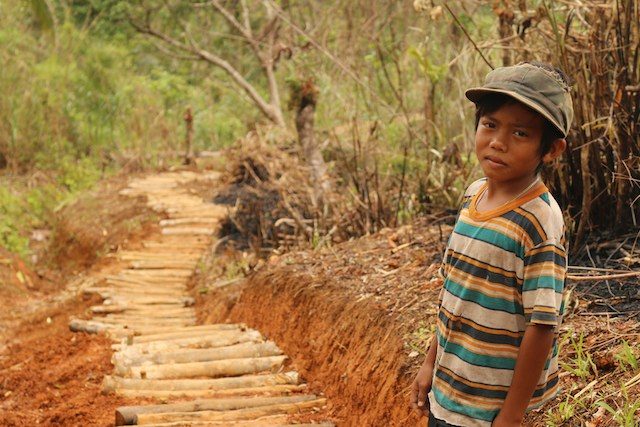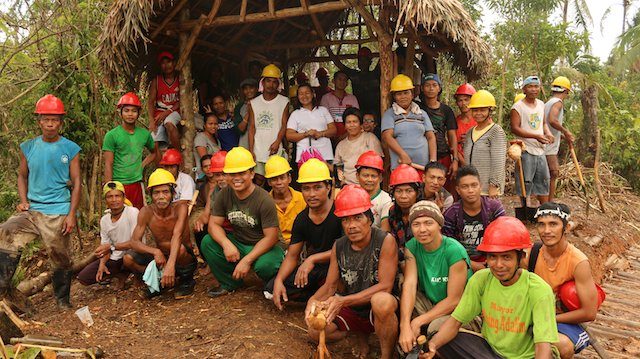SUMMARY
This is AI generated summarization, which may have errors. For context, always refer to the full article.

MANILA, Philippines – “Where is your school?” “It’s near, just a 3-hour trek from the mountain.”
Gerard Loreso is just 10 years old. He barely smiles. His head always low, his right hand playing with the other. He wears a rugged cap – too rugged, it tells a story of the years it has endured. His feet do not look like those of a child. They show persistence, walking to and from the mountain every day, just to get a little closer to something better – to his dreams.
“I didn’t want to quit school even if it meant I had to walk more than three hours a day up a slippery mountain. I want to become a teacher, so I need to go to school.”
His community in Taft, Eastern Samar is one of the hardest-hit areas by Typhoon Hagupit (international codename: Ruby). The mountain, which serves as their farm-to-market road, was littered with debris. The landslides also washed out all the wooden steps which make the trail easier for the villagers.
As a result, students like Gerard became more vulnerable to accidents because of the slippery road. Most families whose houses were destroyed by the typhoon moved to the mountain. Children had no other choice but to endure long hours of walking – rain, hail or shine just to continue going to school.
“We used to have a small house near the river but it was totally destroyed by the typhoon. We then needed to move in to the mountain,” Perla, Gerard’s mother explains.
“I want Gerard to continue with his studies, but as a mother, I worry for his safety. Although we have warned him how climbing the mountain is dangerous, he is still a child with a playful nature. Aside from the mountain, he also needs to cross the river to get to his school. What if something happens?” Perla says in a worried voice.

Wooden steps to make the mountain safer
Through World Vision’s cash for work program, the community were able to replace the wooden steps and clear fallen coconut trees.
“The people here carry 20-50 kilos of their products every day. You can only imagine what it was like when the fallen trees were blocking the path without the steps,” says village captain Narciso Adao. He adds that the steps covered about 4 kilometers of the 200 ft high mountain. People in the village built a nipa hut at the 600-step mark so that people have a place to rest, and to shelter them during rainy season.
“I am very happy to be a part of this program. I feel like I am doing myself a favor and at the same time being paid to do it,” says 64-year old Citoy. He earns P100 for transporting 20 kilos of charcoal from the mountain to the market. He adds that a place to sit down and rest will be beneficial to him and other community members.
As for Gerard, he is now more determined to not quit his studies. “Thank you for making it easier for us to get to our school. One day, I am going to be like my teacher Lida,” he smiles, referring to his favorite teacher.
World Vision partners with 16 villages for the implementation of 52 cash for work projects that include creek clearing and de-clogging, communal vegetable gardening, school reconstruction and drainage excavation. The intervention will benefit 3,250 families.
To date, 14 barangays have completed the 15-day community work and the team is expecting to finish by the first week of March. Unconditional cash transfer of a total amount of P3,900 ($74) was also be given to 500 of the most vulnerable families.
“It’s heartwarming to see the people own the projects in their respective communities. Aside from the agreements made with the village council and the local government to ensure project continuity, the enthusiasm of the people to work their way out of the chaos gives us confidence even after we leave,” says Cenen Milan, Zonal Manager for Samar.
Typhoon Hagupit lashed the Philippines last December 2014, affecting almost two million people in Eastern Visayas. World Vision immediately provided more than 35,000 people in East and West Samar with emergency essentials such as food and essential items, hygiene kits, water, emergency shelter and water purification kits. – Rappler.com
Joy Maluyo is a Communication Officer for World Vision’s Haiyan Response. She is currently deployed in the Visayas and is moving around World Vision’s assisted areas in Panay Island, North Cebu, and Leyte.
*USD1 = P44
Add a comment
How does this make you feel?
There are no comments yet. Add your comment to start the conversation.